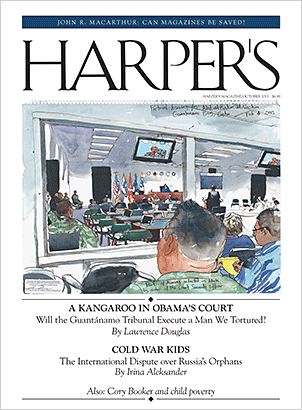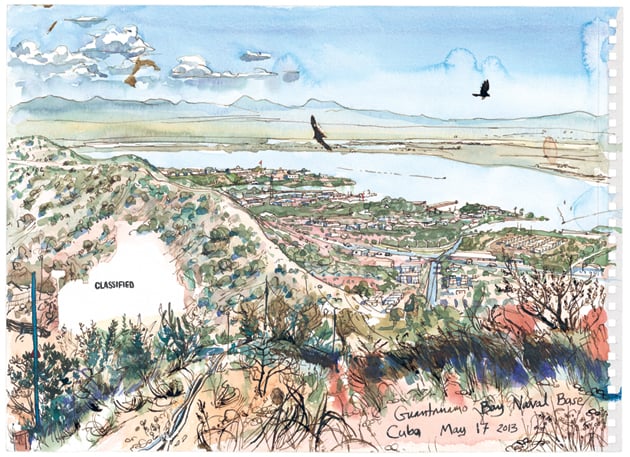Steve Mumford and Lawrence Douglas at Postmasters Gallery in New York City
Join us Saturday, October 26, at 6:30 p.m.
On Saturday, October 26, at 6.30 p.m., Harper’s Magazine and Postmasters Gallery will present a conversation with contributing artist Steve Mumford, writer Lawrence Douglas, and Harper’s art director Stacey Clarkson.
Known for his drawings from the war zones of Iraq and Afghanistan, Steve Mumford made two trips to Guantanamo in February and May 2013 for Harper’s. A portfolio of his drawings accompany Lawrence Douglas’ October cover story “A Kangaroo in Obama’s Court.”
 Of the experience, Mumford wrote:
Of the experience, Mumford wrote:
I traveled to Guantanamo Naval Base for the first time last winter, to illustrate a story for Harper’s Magazine on the military trial of Abd al-Nashiri, accused of leading the attack on the U.S.S. Cole, and tortured many times while in U.S. custody.
Nashiri, quiet and wearing an unassuming grey shirt, was hardly noticeable as I drew the scene through the multiple sealed panes of security glass in the media area at the far rear of the large, bland courtroom. More striking were the overhead TV screens and audio of the same scene, on a forty-second delay, a disorienting counterpart to the live scene in front of us and a perfect embodiment of the secrecy and paranoia embedded in Gitmo’s culture.
The hearings lasted a day and a half before getting sidelined by delays; with several days left, I poked around the sprawling U.S.-administered piece of Cuba with my escort from the Public Affairs Office, looking for compelling things to draw.
I found my subject in Camp X-Ray, a hauntingly beautiful ruin of a simple prison camp, hastily erected on a scrubby, deserted, windswept plain overlooked by a ridge of distant hills. I could see the guard towers of the Cuban border following that ridge, looking down at us.
X-Ray consists of nothing more than chain-link fencing, razor wire, and a few plywood huts and guard towers. Abandoned for a decade, nature has taken over: the fencing and razor wire i covered in vines, many of which were in flower on my second visit. Wild grass has spread throughout the grounds, and huge iguanas and banana rats have made X-Ray their home. At one edge of the camp sit the forlorn wooden huts, slowly settling into the earth. Their plywood floors are strewn with droppings, and vines are crowding in. This is where the CIA applied its “enhanced interrogation” techniques to the newly arrived prisoners from Afghanistan. The wind constantly whistles through these sun-soaked, haunted spaces.
The prisons where the last 166 detainees are being held are small, high-security fortresses, their design and detail impregnable and generic. It was in one of these where a sergeant of the military-police unit in charge of the prison incredulously informed me that there was no way I would be able to see, let alone draw, any of the detainees, even though this had been the stated purpose of the trip, and had been agreed to by the Public Affairs Unit.
For two days I drew the interior of the facility, as well as the MPs assigned to me while they lounged on bolted-down prison chairs and chatted. Then word would be passed down that a detainee was being moved from somewhere to somewhere else, and I would be hastily escorted to another part of the prison to draw until the danger of us seeing one another was over.
I drew everything associated with the prisoners but the prisoners themselves. I even drew a dim hallway echoing with the strains of an early morning call to prayer, as the prisoners crouched in their cells a few feet away, behind thick steel doors.
I only once caught a glimpse of some detainees, when a cord snapped, the wind blew some fabric away from a fence, and I saw — momentarily, magically — a few distant figures, lean in white T-shirts, playing soccer. Then they were gone.
The subject of my Gitmo drawings is the very thing never pictured. And then the subject becomes the reason why they aren’t there.
I am reminded of a passage from Peter Matthiessen’s classic travel memoir about expectation, ambition, and self. Matthiessen desperately wants to see the animal he’s journeyed so far to write about but is destined to never see. Before he leaves, his Zen teacher tells him: Expect nothing.
It doesn’t exactly work, and yet it does.
—September 2013



